Spatial Analysis of Socioeconomic Factors Contributing to Food Desert in North Carolina
Abstract
:1. Introduction
2. Methodology
2.1. Conceptual Framework
2.2. Data and Study Area
2.2.1. Data
- (a)
- FD Maps: USDA FD maps indicate areas where people have limited access to affordable and nutritious food based on food availability, income levels, and transportation infrastructure.
- (b)
- Census Tract: Census tracts are critical data for analyzing demographic and economic data in the United States, reporting essential statistics such as population size, age, race and ethnicity, income, education, housing, and employment. Government agencies, researchers, and policy makers widely use the data collected through census tracts to make informed decisions regarding public policy, business strategy, and community development. Census tracts play a significant role in identifying areas that require attention and intervention to ensure equitable development and informed decision-making.
- (c)
- Land Use and Land Cover: Land use and land cover are two distinct concepts yet closely related. While land use entails human decision activities that determine how land is utilized, land cover refers to the physical features of the land’s surface including manmade structures and natural vegetation [17]. Therefore, strategic land use decisions can significantly enhance food production in specific areas [18] through optimal land use practices.
2.2.2. Study Area
- Guilford County covers a 645-square-mile area with an estimated population of 542,410 as of 2021 and is the third most populous county in the State (U.S. Census Bureau-QuickFacts, 2021).
- Bladen County is in the southeastern part, primarily a rural county with approximately 33,000 people. The county’s economy is predominantly agricultural, with peanut production being a significant crop.
- Rutherford County is in the western part of the State of North Carolina in the United States. It is situated in the foothills of the Appalachian Mountains and covers an area of approximately 566 square miles. The county has a population of approximately 67,000 people, with the largest city and county seat being Rutherfordton.
2.2.3. Spatial and Socioeconomic Analysis
- ▪
- (a) 0.5–10: Any low-income census tract where a substantial percentage of the population is more than half a mile(urban) or ten miles (rural) from the nearest grocery store.
- ▪
- (b) 1–10: A low-income census tract with substantial population size in an area more than a mile(urban) or ten miles (rural) away from a supermarket.
- ▪
- (c) 1–20: A low-income census tract with a substantial population size in an area more than a mile(urban) or twenty miles (rural) away from a supermarket.
- ▪
- (d) Vehicle: where thirty-three percent of the population is away from the closest supermarket for more than 20 miles regardless of vehicle access.
3. Results
Socioeconomic Characteristics
4. Discussion
Author Contributions
Funding
Institutional Review Board Statement
Informed Consent Statement
Data Availability Statement
Acknowledgments
Conflicts of Interest
References
- Aun, J.J. The Intersection of Food Deserts and Food Assistance Deserts in El Paso County, Texas. Master’s Thesis, The University of Texas at El Paso, El Paso, TX, USA, 2020. [Google Scholar]
- Ver Ploeg, M.; Breneman, V.; Dutko, P.; Williams, R.; Snyder, S.; Dicken, C.; Kaufman, P. Access to Affordable and Nutritious Food: Updated Estimates of Distance to Supermarkets Using 2010 Data (No. 1477-2017-3993); AgEcon Search: St. Paul, MN, USA, 2012. [Google Scholar]
- Fitzpatrick, K.; Greenhalgh-Stanley, N.; Ploeg, M.V. Food deserts and diet-related health outcomes of the elderly. Food Policy 2019, 87, 101747. [Google Scholar] [CrossRef]
- Penne, T.; Goedemé, T. Can low-income households afford a healthy diet? Insufficient income as a driver of food insecurity in Europe. Food Policy 2021, 99, 101978. [Google Scholar] [CrossRef]
- Coleman-Jensen, A.; Rabbitt, M.P.; Gregory, C.A.; Singh, A. Statistical Supplement to Household Food Security in the United States in 2021 (No. 1962-2022-1838); US Department of Agriculture: Washington, DC, USA, 2022. [Google Scholar]
- Compton, M.T.; Ku, B.S. Prevalence of food insecurity and living in a food desert among individuals with serious mental illnesses in public mental health clinics. Community Ment. Health J. 2023, 59, 357–362. [Google Scholar] [CrossRef] [PubMed]
- Casey, A.H.; Pylypiw, N. Running the numbers: Measuring food hardship in North Carolina communities. North Carol. Med. J. 2022, 83, 126–129. [Google Scholar] [CrossRef] [PubMed]
- Testa, A.; Jackson, D.B.; Semenza, D.C.; Vaughn, M.G. Food deserts and cardiovascular health among young adults. Public Health Nutr. 2021, 24, 117–124. [Google Scholar] [CrossRef] [PubMed]
- Goodman, M.; Thomson, J.; Landry, A. Food environment in the lower Mississippi Delta: Food deserts, food swamps and hot spots. Int. J. Environ. Res. Public Health 2020, 17, 3354. [Google Scholar] [CrossRef] [PubMed]
- Rhone, A. Updated Food Access Research Atlas Now Maps Changes in Low-Income and Low-Supermarket Access Areas in 2019. In Amber Waves: The Economics of Food, Farming, Natural Resources, and Rural America, 2021 (1490-2021-1194); AgEcon Search: St. Paul, MN, USA, 2021. [Google Scholar]
- Kotval-K, Z.; Khandelwal, S.; Wills, K. Access to foods using Grand Rapids, Michigan, as a case study: Objective versus subjective issues. J. Agric. Food Syst. Community Dev. 2021, 10, 145–159. [Google Scholar]
- Buys, D.R.; Rennekamp, R. Cooperative extension as a force for healthy, rural communities: Historical perspectives and future directions. Am. J. Public Health 2020, 110, 1300–1303. [Google Scholar] [CrossRef] [PubMed]
- Jones, R.E.; Walton, T.N.; Duluc-Silva, S.; Fly, J.M. Household food insecurity in an urban food desert: A descriptive analysis of an african american community. J. Hunger. Environ. Nutr. 2022, 17, 670–688. [Google Scholar] [CrossRef]
- Center for Diseases Control. Food Access Through Land Use Planning and Policies. Available online: https://www.cdc.gov/nccdphp/dnpao/health-equity/health-equity-guide/pdf/health-equity-guide/Health-Equity-Guide-sect-3-4.pdf (accessed on 18 January 2023).
- United States Census Bureau. American Survey Community, State Profiles: North Carolina. Available online: www.census.gov/library/stories/state-by-state/north-carolina-population-change-between-census-decade.html (accessed on 2 February 2023).
- United States Food Access Research AtlasFARA. Available online: https://www.ers.usda.gov/data-products/food-access-research-atlas/ (accessed on 2 February 2023).
- United States Department of Agriculture. Economic Research Services. Land Use and Land Cover Estimates for the US. Available online: https://www.ers.usda.gov/about-ers/partnerships/strengthening-statistics-through-the-icars/land-use-and-land-cover-estimates-for-the-united-states/ (accessed on 2 February 2023).
- Gebrehiwot, A.A.; Hashemi-Beni, L.; Kurkalova, L.A.; Liang, C.L.; Jha, M.K. Using ABM to Study the Potential of Land Use Change for Mitigation of Food Deserts. Sustainability 2022, 14, 9715. [Google Scholar] [CrossRef]
- Hashemi-Beni, L.; Kurkalova, L.A.; Mulrooney, T.J.; Azubike, C.S. Combining Multiple Geospatial Data for Estimating Aboveground Biomass in North Carolina Forests. Remote Sens. 2021, 13, 2731. [Google Scholar] [CrossRef]
- Kurkalova, L.A.; Hashemi Beni, L.; Liang, C.L. Vegetable Production: Land Use Perspective; AgEcon Search: St. Paul, MN, USA, 2021. [Google Scholar]
- Dhamankar, S.S.; Hashemi-Beni, L.; Kurkalova, L.A.; Liang, C.L.; Mulrooney, T.; Jha, M.; Monty, G.; Miao, H. Study of Active Farmland Use To Support Agent-Based Modeling Of Food Deserts. Int. Arch. Photogramm. Remote Sens. Spat. Inf. Sci. 2020, XLIV-M-2-2, 9–13. [Google Scholar] [CrossRef]
- Barcus, H.; Lanegran, D.A. The Changing Rural Periphery: Contested Landscape, Agricultural Preservation, and New Rural Residents in Dakota County, Minnesota, USA. In Rural Transformations; Routledge: Oxfordshire, UK, 2022; pp. 91–112. [Google Scholar]
- Sigalo, N.; St Jean, B.; Frias-Martinez, V. Using Social Media to Predict Food Deserts in the United States: Infodemiology Study of Tweets. JMIR Public Health Surveill. 2022, 8, e34285. [Google Scholar] [CrossRef] [PubMed]
- McLoughlin, G.M.; McCarthy, J.A.; McGuirt, J.T.; Singleton, C.R.; Dunn, C.G.; Gadhoke, P. Addressing food insecurity through a health equity lens: A case study of large urban school districts during the COVID-19 pandemic. J. Urban Health 2020, 97, 759–775. [Google Scholar] [CrossRef] [PubMed]
- Karpyn, A.E.; Riser, D.; Tracy, T.; Wang, R.; Shen, Y.E. The changing landscape of food deserts. UNSCN Nutr. 2019, 44, 46. [Google Scholar] [PubMed]
- Dhamankar, S.S.; Hashemi-Beni, L.; Kurkalova, L.A.; Liang, C.L.; Mulrooney, T.; Jha, M.; Miao, H. Study of Active Farmland Use to Support Agent-Based Modeling of Food Deserts; The International Archives of the Photogrammetry Remote Sensing and Spatial Information Sciences: Beijing, China, 2020; Volume 44. [Google Scholar]
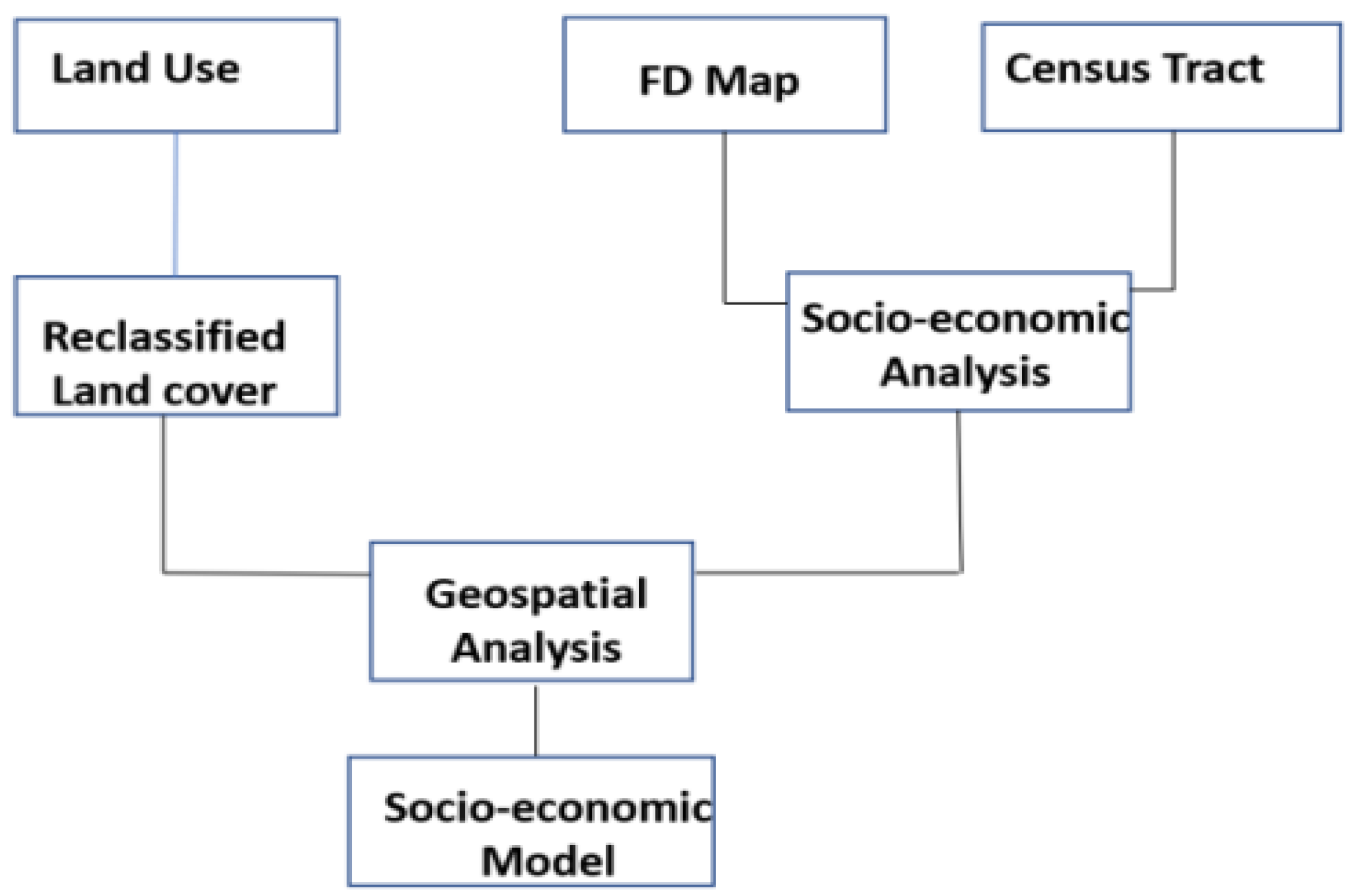
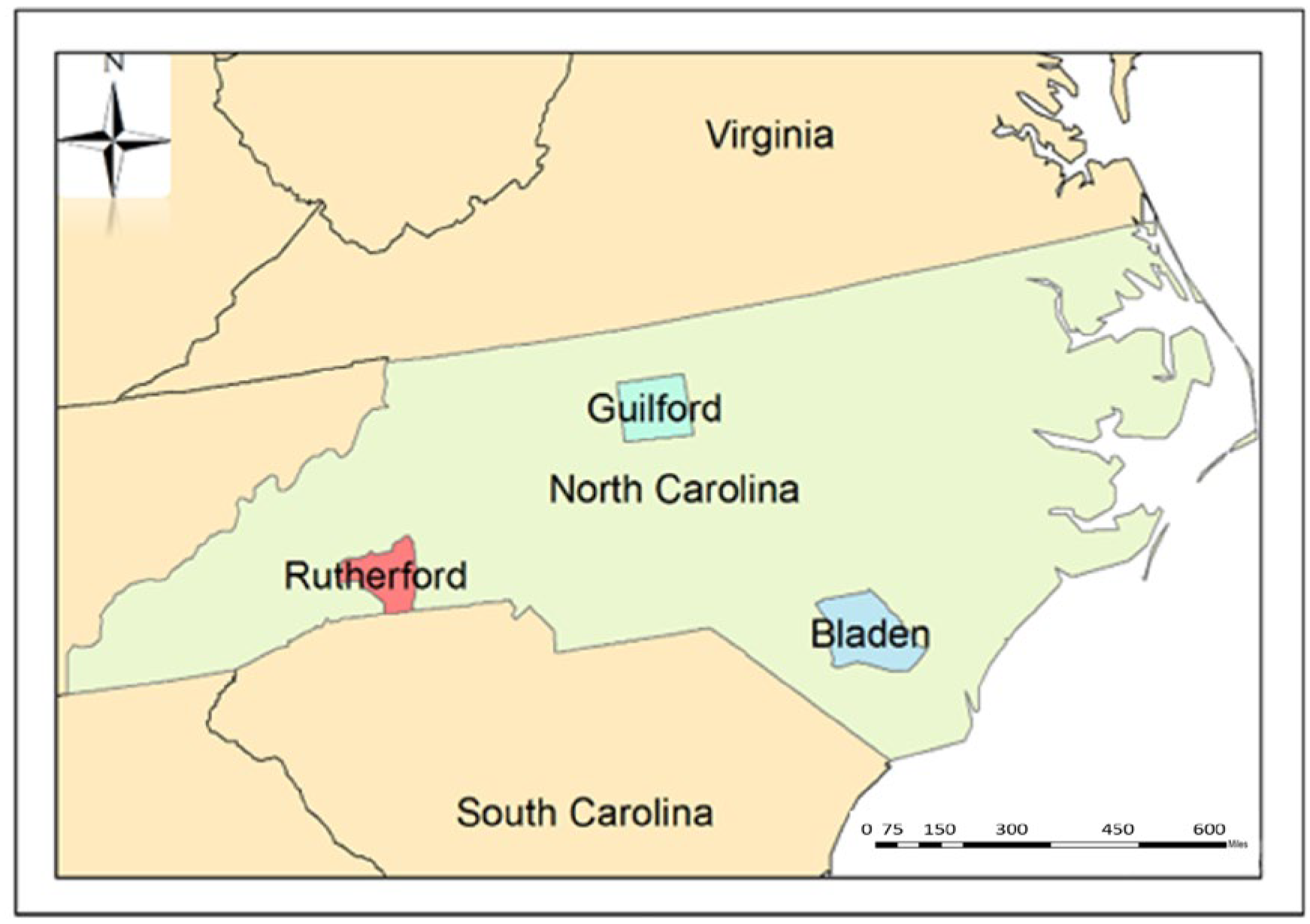
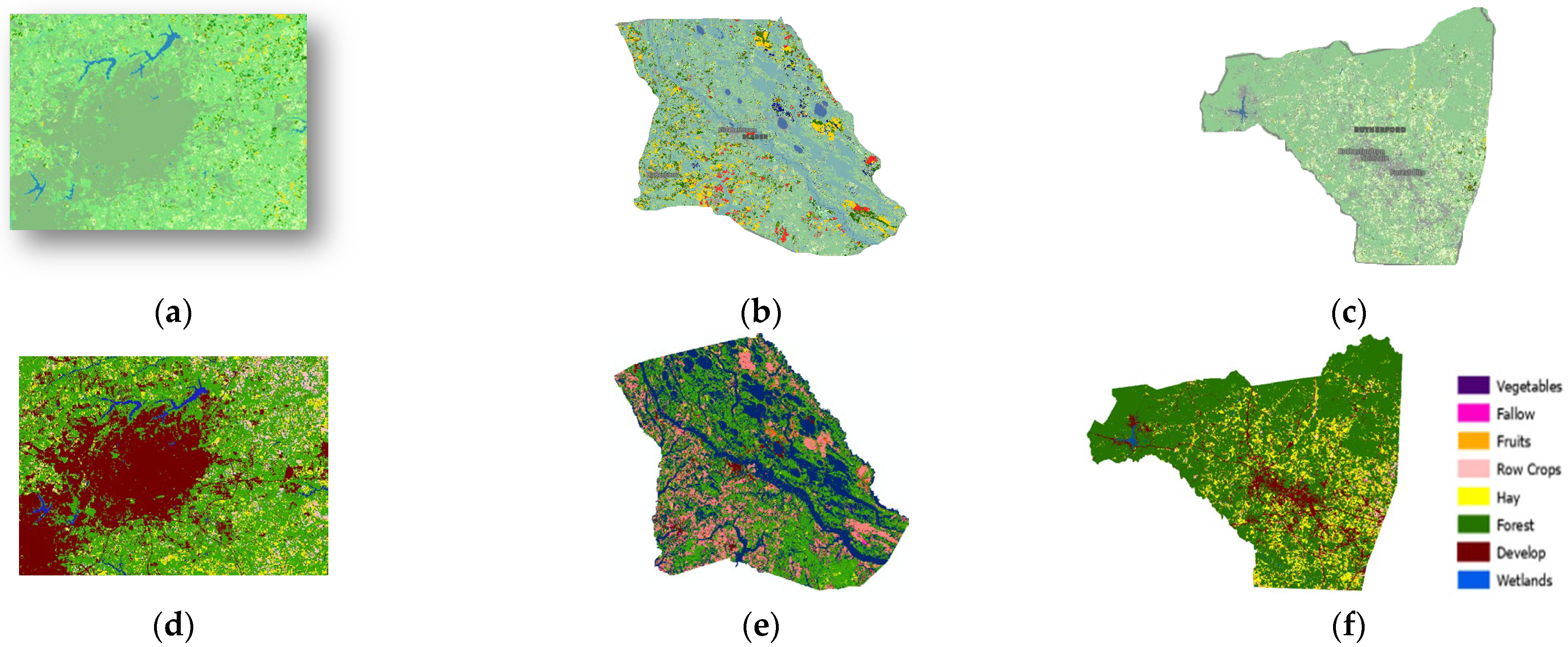
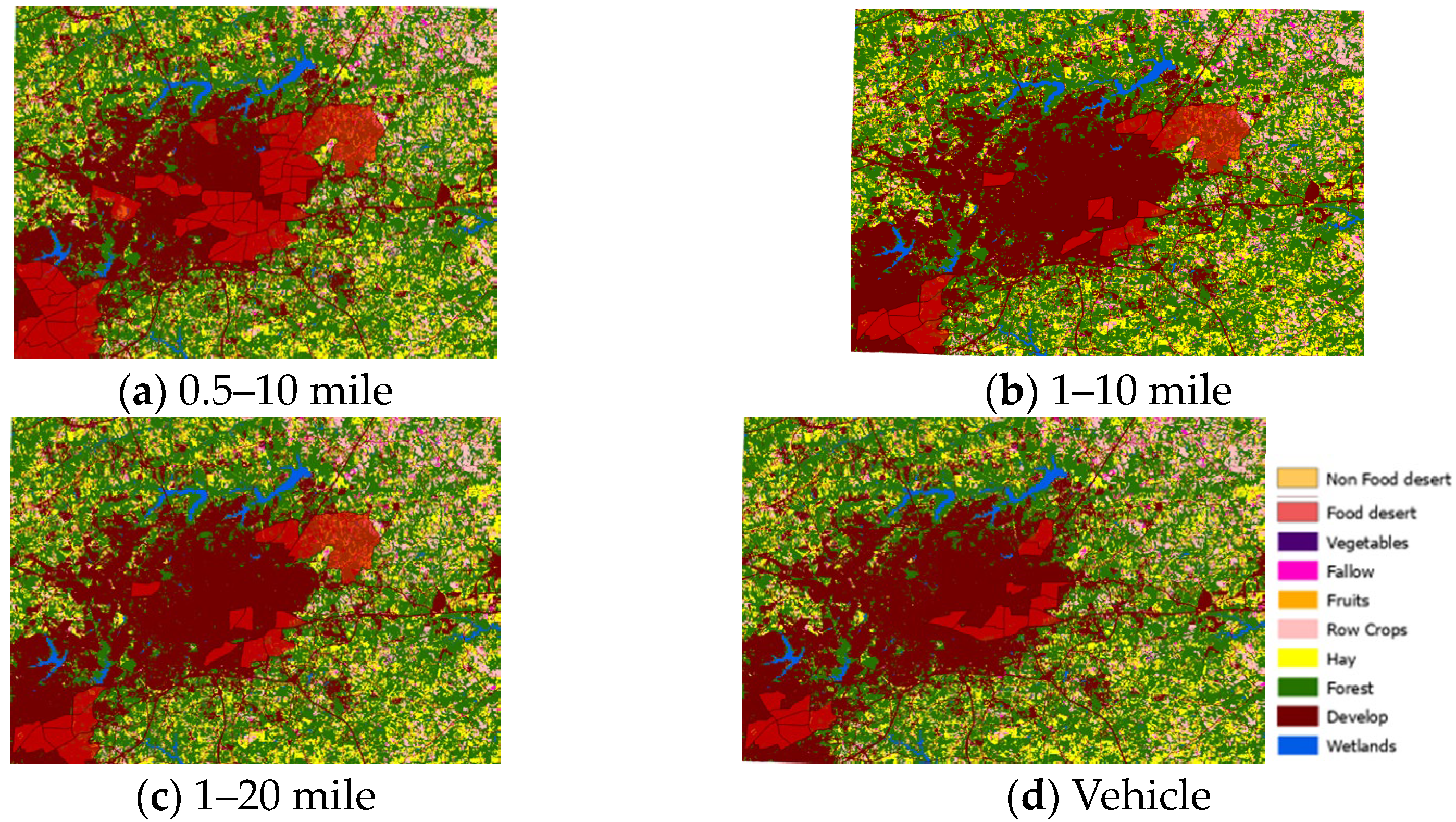
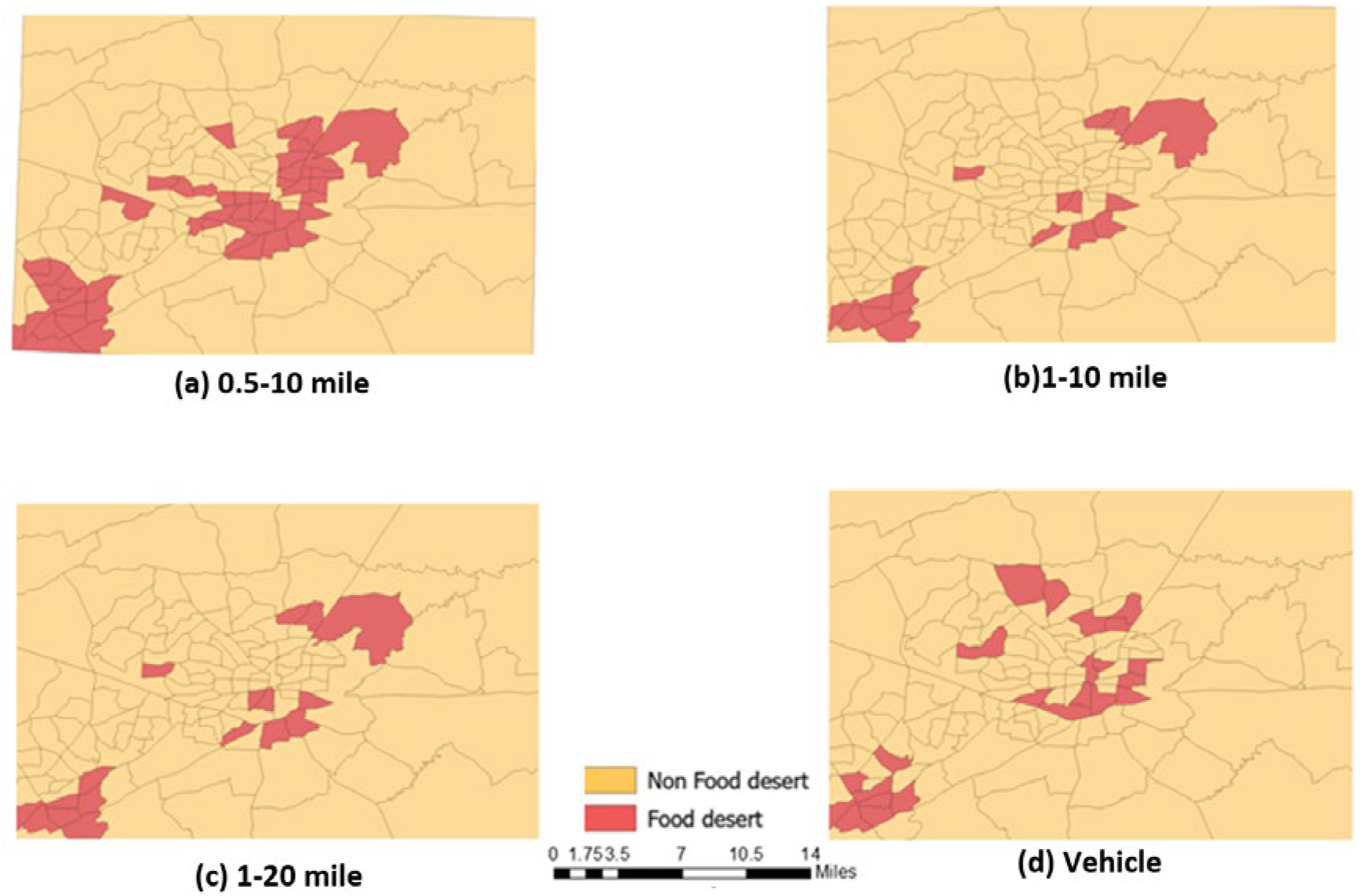
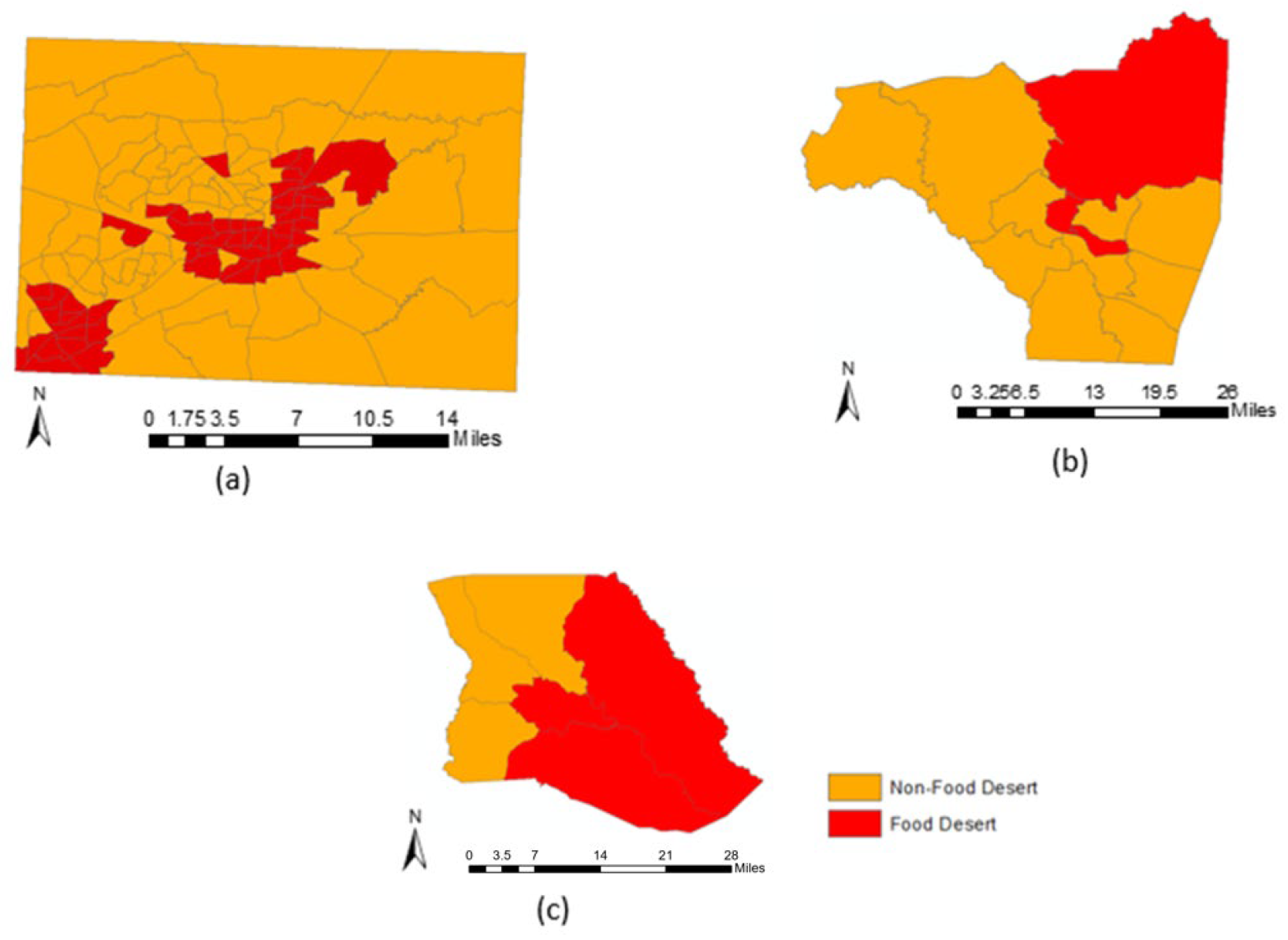

| Old Classification | New Classification | Type |
|---|---|---|
| 12; 43; 46–50; 53; 54; 57; 206–209; 213; 214; 216; 219; 222; 229; 243; 245–248 | 1 | vegetables, potatoes, and melons (VMP) |
| 61 | 2 | fallow/idle |
| 55; 67–69; 74; 77; 218; 221; 242; 250 | 3 | fruits, nuts, and berries (F.N.B) |
| 1–6; 10; 11; 21; 23–32; 34; 39; 41; 42; 44; 60; 205; 224–226; 228; 235–241; 254 | 4 | row crop(field crops) |
| 36; 37; 58; 176 | 5 | hay, grass, or pasture (Hay and forage crops) |
| 13; 59; 63; 70; 71; 141–143; 152 | 6 | cultivated Christmas tree (CCT), nursery greenhouse floriculture (NGF), and forests |
| 121–124; 131 | 7 | developed or barren |
| 87; 92; 111; 190; 195 | 8 | wetlands, aquaculture, water |
Disclaimer/Publisher’s Note: The statements, opinions and data contained in all publications are solely those of the individual author(s) and contributor(s) and not of MDPI and/or the editor(s). MDPI and/or the editor(s) disclaim responsibility for any injury to people or property resulting from any ideas, methods, instructions or products referred to in the content. |
© 2023 by the authors. Licensee MDPI, Basel, Switzerland. This article is an open access article distributed under the terms and conditions of the Creative Commons Attribution (CC BY) license (https://creativecommons.org/licenses/by/4.0/).
Share and Cite
Tanoh, V.; Hashemi-Beni, L. Spatial Analysis of Socioeconomic Factors Contributing to Food Desert in North Carolina. Sustainability 2023, 15, 7848. https://doi.org/10.3390/su15107848
Tanoh V, Hashemi-Beni L. Spatial Analysis of Socioeconomic Factors Contributing to Food Desert in North Carolina. Sustainability. 2023; 15(10):7848. https://doi.org/10.3390/su15107848
Chicago/Turabian StyleTanoh, Victoria, and Leila Hashemi-Beni. 2023. "Spatial Analysis of Socioeconomic Factors Contributing to Food Desert in North Carolina" Sustainability 15, no. 10: 7848. https://doi.org/10.3390/su15107848
APA StyleTanoh, V., & Hashemi-Beni, L. (2023). Spatial Analysis of Socioeconomic Factors Contributing to Food Desert in North Carolina. Sustainability, 15(10), 7848. https://doi.org/10.3390/su15107848






